How butt welding of polyethylene pipes is performed: briefing on the work
Pipes from polyethylene with a diameter of 2-120 cm are often used for laying water pipes, gas pipelines, storm sewer equipment. They are durable, resistant to corrosion, lightweight, easy to install. Welding is used to connect products. It can be of different types. The most popular butt welding of polyethylene pipes. It provides a tight and aesthetic-looking seam.
Usually, specialists are hired to lay the trunk. But, you see, professional services are not cheap? In addition, not all craftsmen are conscientious and responsibly approach the execution of the order. If you have certain knowledge and skills, then you can do the work yourself. This will save money and guarantee a quality result.
We will talk about the technology for welding butt-welded polyethylene pipes, give a detailed algorithm of actions, give links to regulatory documents and tips that should be followed when doing such work.
The content of the article:
How to perform butt welding?
Butt welding is popular today. This method is used not only in industry, but also in everyday life. It is used to connect homogeneous workpieces. Butt welding has several advantages over other technologies.
For its implementation, couplings and other elements are not needed. This allows you to save money on the purchase of additional materials. The technology used ensures the preservation of flexibility and strength. With its help, you can connect pieces of products of different lengths. At the same time, the strength at the weld point will not be lower than on other solid sections.
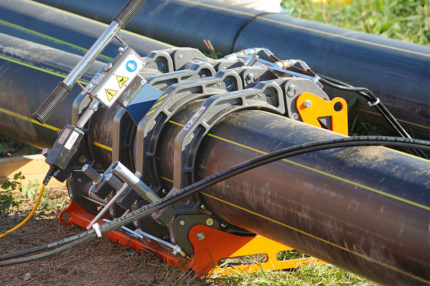
Butt welding can be performed by reflow and resistance. Each of the options has its own characteristics, pros and cons.
Reflow welding
The essence of welding with this method is that the joints of the pipe are melted under the influence of a heated tool to viscous flow. Then the ends are connected under pressure and kept to cool completely. The result is a tight seam.
In order for the connection to be of high quality, it is necessary to firmly press the sections of the product after heating. The use of modern equipment allows you to partially automate and simplify such work. With its help, the operation of joining pipes by the reflow method is carried out as soon as possible.
Resistance welding
The essence of butt resistance welding is that the edges of the pipes are pressed against electrodes that are equipped with special jaws. This provides high-quality electrical contact. No slipping of material between the electrodes.
Then two pipes are pressed tightly against each other and fixed. Next, welding current is supplied. The contacting sections of the material are melted and under pressure are combined into one product. The resulting design has a low resistance to oxidation during operation. This significantly limits its scope.
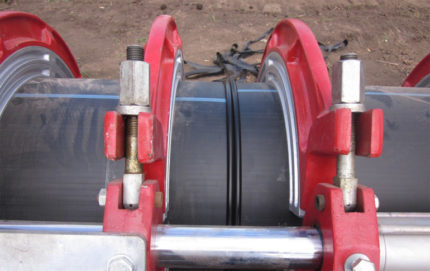
Resistance welding is only suitable for pipes with a small cross section. Therefore, in large-scale production, for laying large highways it is rarely used.
What to choose for polyethylene pipes?
Often, polyethylene material is used to lay the pipeline. This is due to its low price and excellent performance.
It is worth remembering that polyethylene is a dielectric. Therefore, he, unlike metal, does not conduct current. To connect products from it, it is recommended to use the reflow method. By the method of butt welding with resistance on polyethylene, a seam cannot be made. It is necessary to use equipment that heats the slices of two parts.
Welding by melting polyethylene pipes has a number of features. Firstly, the details are brought to each other at low speed. Secondly, the voltage throughout the process remains unchanged. Thirdly, all microroughnesses disappear due to the uniform supply of the connected elements. Fourthly, to ensure maximum contact area, the surface of the workpiece is melted.
Can I weld on my own?
The laying of a polyethylene line by butt welding has its own characteristics and differences from other methods of joining two products.
For its implementation, certain knowledge and experience are needed. Otherwise, the design will come out of low quality and short-lived.
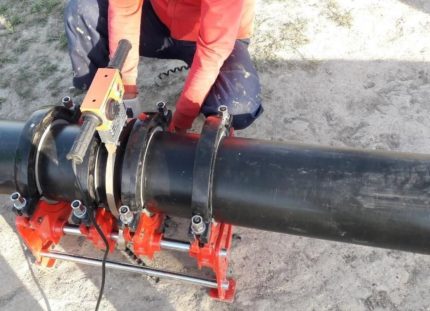
The butt welding method is not easy to implement. Not everyone succeeds in completing the pipe connection qualitatively the first time. If there is no knowledge and skills in the field of welding, it is better to turn to a professional craftsman for laying the line. But for the work he will have to pay an impressive amount.
If a person previously carried out welding by other methods, for example, electrofusion, then he will most likely be able to master the butt technology. Therefore, it makes sense to try to hold connection of polyethylene pipes by yourself. But it must be borne in mind that the butt welding technology is more complicated than in the case of connecting polyethylene pipes with an electrofusion coupling.
To do the job efficiently with your own hands, you need to have special equipment. It can be rented. It will be much cheaper than buying a new or used device. It is important to know the step-by-step instructions for flash butt welding and adhere to it clearly.
Butt Welding Instruction
Butt welding using reflow technology is used to connect polyethylene products, in particular pipes. With its help also make installation fittings and other details.
For hard-to-reach, complex areas, this method is not used. In such cases, electrofusion welding is more suitable.
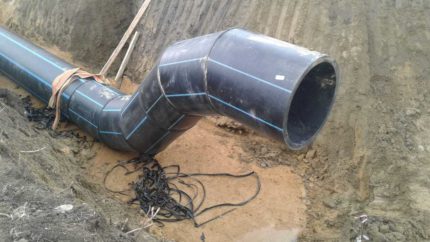
In order for butt welding to be successful and the seam to be neat and durable, you must adhere to a certain algorithm of actions.
Step-by-step instructions are given below:
- Prepare welding equipment.
- Arrange the necessary conditions.
- Prepare the pipes.
- Carry out welding work.
- Wait for the material to cool and fix the result.
Each of these stages has its own characteristics, rules of conduct. We will talk about them below in more detail.
Welding equipment preparation
For welding two segments of polyethylene pipes by the joining method, special equipment is required. It centers, mallets, melts and connects the edges of the products under the required pressure.
The modern market offers a wide selection of such devices. There are devices with mechanical, hydraulic drives and those that are equipped with program control. The latter are more convenient to use.
Butt welding machines have a standard design. They without fail include such components: centralizer, trimming, heating element, pressure reducing liners, drive.
The centralizer is designed to fix the workpieces in the right position and fix the connected ends of the polyethylene pipes. It is equipped with two movable and two fixed clamps.
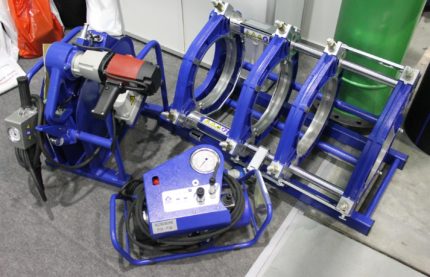
The crosscutter allows you to process the cut so that the ends of the two parts are completely in contact. According to the rules, a gap of not more than 0.05 cm is allowed for medium and small pipes.
For large-sized products, this value increases to 0.07 cm. If, after the first processing at the docking, the gap is greater than the established standard, then the crosscutter is again used.
The heating element is in the form of a plate coated with Teflon. He repeats the shape of the pipe. The drive brings together and connects the heated and molten joints of two products. Gear bushings prevent deformation of the product.
In automated equipment there is a control unit equipped with buttons. Such devices provide simplicity and accuracy of the welding process. This eliminates the likelihood of making a mistake.
It is enough to correctly position the two pipes that need to be connected and click on the corresponding button. Modern equipment has high performance, but is expensive.
Creation of necessary conditions
Flash butt welding technology is simple to use. But it can be applied far from in all cases. It is important that a number of conditions are met.
Butt welding is possible only for pipes that are made of one type of polyethylene and which have the same diameter. The wall thickness of the product should not be less than 0.5 cm. Work is permissible only at a certain temperature range: from -15 to +45 degrees.
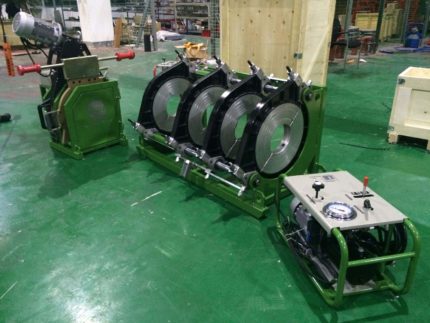
The butt welding method is only implemented if it is possible to reliably fix and press the ends of the pipes to be joined together. In the presence of a special apparatus, this does not arise.
Preparation of polyethylene pipes
To get a high-quality, tight and aesthetic seam when connecting polyethylene pipes by a welded butt method, you must first prepare the products. Check the ovality of the polyethylene piping. It is recommended to compare the wall thickness. It should be the same.
Also, products should be prepared mechanically. To do this, use cropping, milling. This will connect the pipes in the desired position.
It is recommended to use an electric trimmer. He will cut the pipe at the right angle. It is important that the edges of the workpieces are flat and completely in contact with each other.
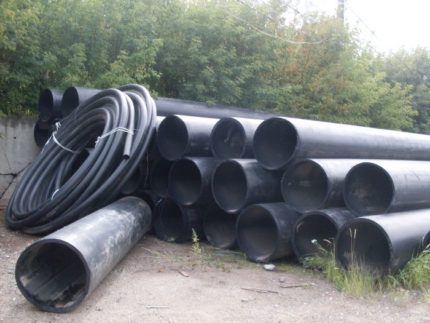
It is necessary to remove contaminants from the surface of parts - dust, dirt, etc., moisture. This may require two soft, dry rags, a special cleanser.
Butt welding
Butt welding by reflow and subsequent joining of two parts on their own is best done in automatic mode. This will provide the desired result.
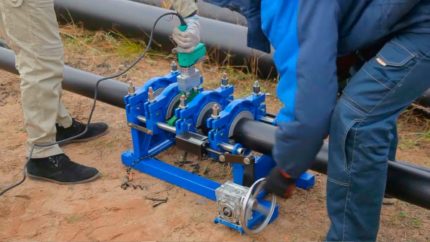
Regardless of whether automatic or mechanical equipment is used for butt welding, the algorithm of actions will be the same.
The process is performed in the following order:
- arrange the two pipes to be joined by welding in a centralizer and fix them. Between products there should be a distance of about four centimeters;
- chamfer and strip products;
- the ends of the pipelines are simultaneously heated with a welding mirror. The polyethylene material is usually melted by 2 mm. This happens fast enough;
- carefully remove the heating element;
- tightly connect the heated joints of the pipelines and fix them in this position;
- withstand pressure.
As a result, an even tight connection with external deposition in the weld area should be obtained.
Process time
A different amount of time can take to weld the polyethylene pipes by reflow with subsequent joining. Much depends on the outer diameter of the workpieces. The larger it is, the longer the material heats up and cools, the more time is given for the connection.
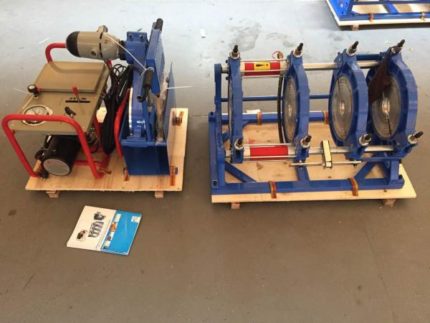
To obtain a durable, tight and neat seam, it is important to know how much to heat the ends of the pipes, to withstand docked products. Similar information is given in the table below.
| Pipe diameter in centimeters | The time to heat the ends of the workpieces in seconds | Connection time in seconds | Time to cool the joined pipes and get a reliable weld in minutes |
| 11,0 | 50 | 12 | 8 |
| 9,0 | 40 | 11 | 8 |
| 7,5 | 30 | 10 | 8 |
| 6,3 | 24 | 8 | 6 |
| 5,0 | 18 | 6 | 4 |
| 4,0 | 12 | 6 | 4 |
| 3,2 | 8 | 6 | 4 |
| 2,5 | 7 | 4 | 2 |
| 2,0 | 7 | 4 | 2 |
| 1,6 | 5 | 4 | 2 |
Most often, butt welding is applied to polyethylene pipes with a diameter of more than 5 cm.
General welding guidelines
When welding plastic pipes by reflow, it is very important to follow the instructions. Departure from technology can lead to overheating of the material and the appearance of an internal influx. This will disrupt the movement of fluids through the pipes.
Also, the seam can turn out to be curved, heterogeneous. In any case, such a design will be considered defective and unsuitable for operation.
There are a number of recommendations that need to be followed in order to achieve the desired result. It is important that the walls do not move more than 10% of their thickness during docking. When cooling the material, the connected parts must be firmly fixed. The time spent on removing the heating plate and joining the two ends of the product should be minimal.
Butt welding of non-pressure sewer pipes made of polymer by a flash method is not recommended. A roll is formed at the junction, on which solid particles can accumulate, leading to clogging of the line.
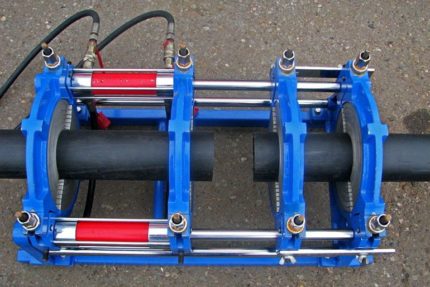
Having decided to lay the pipeline and butt-weld, it is recommended that you first familiarize yourself with the provisions of the relevant GOSTs. These documents contain the rules, requirements for the quality of work, product.
When installing water and gas pipelines, you should focus on GOST R 55276. It describes the technology of butt welding of a polyethylene pipeline.
In relation to equipment for joining products using a similar method, GOST R ISO 12176-1.
Conclusions and useful video on the topic
The order and features of the butt welding of pipes made of polyethylene using a mechanical apparatus:
Butt welding of polyethylene pipes using automatic equipment:
In practice, butt welding of polyethylene pipes with their own hands is not particularly common. This is due to the fact that to perform such work requires special equipment, a certain level of knowledge, skills.
Butt welding of polyethylene pipes should be carried out in accordance with established requirements and rules. This will ensure a high-quality and durable construction. Butt welding has its own technology, features and differences.
You can implement the method with your own hands, but for this it is important to create the necessary conditions, to properly prepare the pipes. If there is no apparatus for welding, then it is more expedient to rent it. It is recommended that you first read the video on the topic of butt welding. It will clearly be easier to understand the essence of the method and the features of its implementation.
Do you have experience in butt welding of polyethylene pipes? Do you want to share your knowledge in this field or ask questions about welding? Please leave comments, take part in discussions - the feedback form is located below.

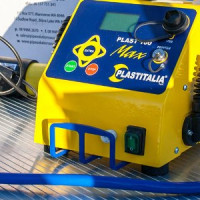 Welding machine for polyethylene pipes: which is better to buy and how to use it correctly
Welding machine for polyethylene pipes: which is better to buy and how to use it correctly 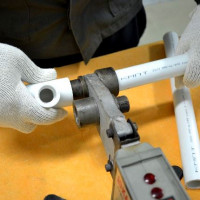 Soldering temperature of polypropylene pipes: the main stages of self-welding + table of values
Soldering temperature of polypropylene pipes: the main stages of self-welding + table of values  Electric welding for beginners: the nuances of welding and the analysis of basic errors
Electric welding for beginners: the nuances of welding and the analysis of basic errors 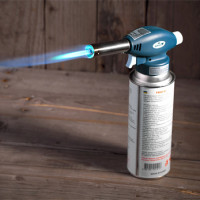 Gas burner for brazing copper pipes: the main types of burners + tips for potential buyers
Gas burner for brazing copper pipes: the main types of burners + tips for potential buyers 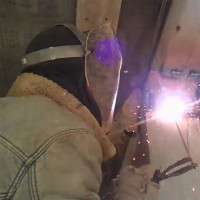 How to cook vertical and horizontal seams with electric welding: step-by-step instructions
How to cook vertical and horizontal seams with electric welding: step-by-step instructions  How much does it cost to connect gas to a private house: the price of organizing gas supply
How much does it cost to connect gas to a private house: the price of organizing gas supply  The best washing machines with dryer: model rating and customer tips
The best washing machines with dryer: model rating and customer tips  What is the color temperature of light and the nuances of choosing the temperature of the lamps to suit your needs
What is the color temperature of light and the nuances of choosing the temperature of the lamps to suit your needs  Replacement of a geyser in an apartment: replacement paperwork + basic norms and requirements
Replacement of a geyser in an apartment: replacement paperwork + basic norms and requirements